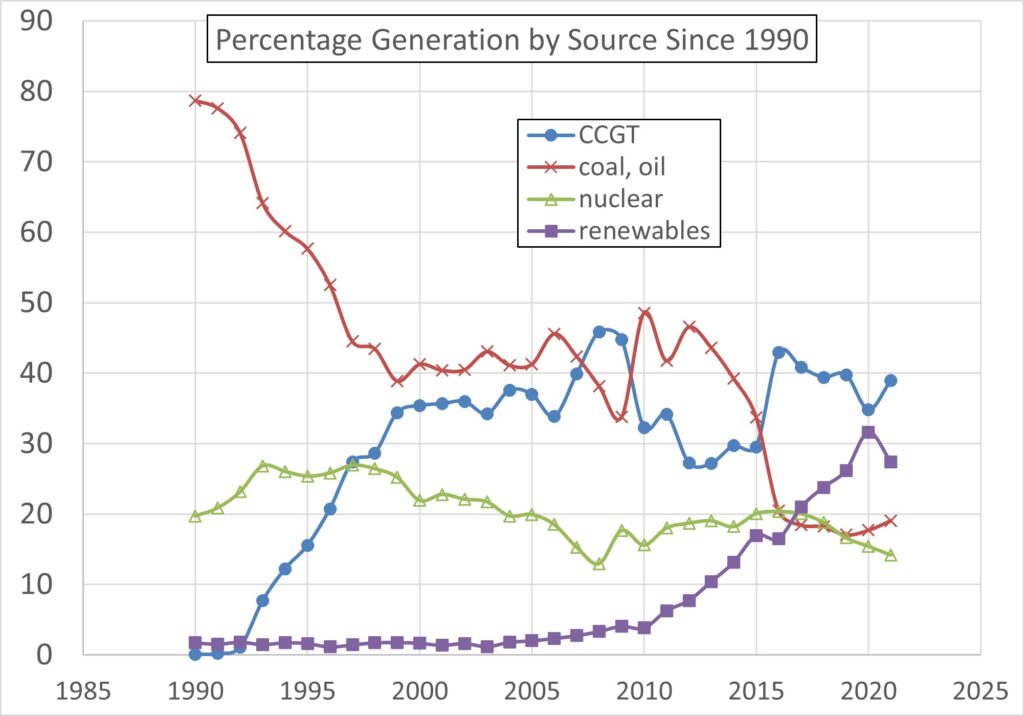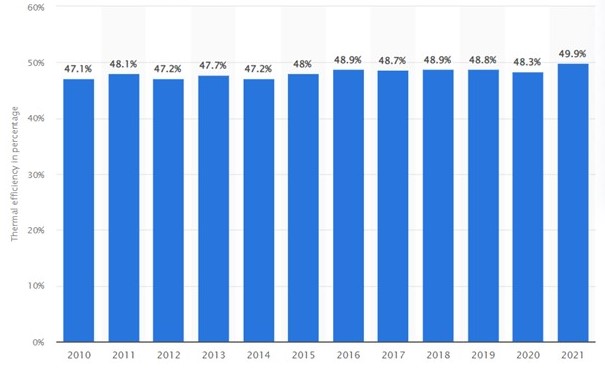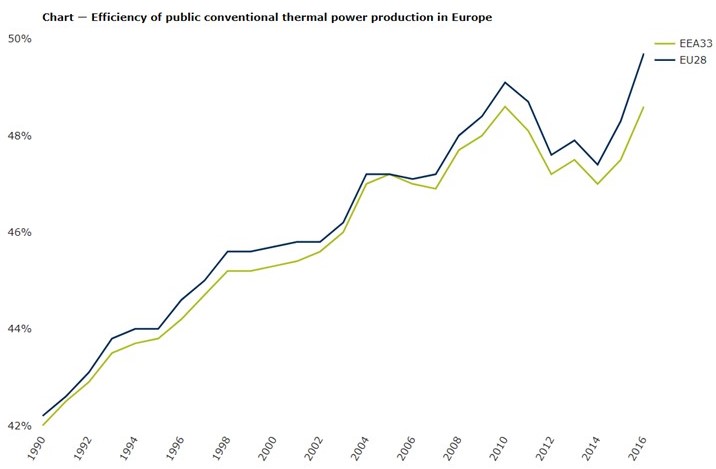
No, I do not refer to carbon-dioxide emissions.
I refer to the efficient use of energy.
I refer to what is long forgotten or never appreciated.
I refer to the huge changes that came about due to privatisation of the electricity generation industry in the UK in 1990.
For simplicity of exposition I shall confine attention to England and Wales, in which, before late 1990, the state-owned Central Electricity Generating Board (CEGB) had a monopoly of electricity generation. In this post I shall not address nuclear power, which was not privatised until 1996.
The CEGB had a legal obligation to maintain supplies of electricity. Since the industry was split up and privatised as smaller companies, no one has had that obligation. Whilst Ofgem and National Grid have certain responsibilities in respect of reviewing capacity and contingency planning, and whilst Ofgem and the Government can, in principle, intervene to influence market conditions, no generators are obliged to address any projected shortfalls in capacity. It is assumed that the market will provide.
As a state-owned monopoly, the CEGB was not constrained by competition and the need to maximise profit. As a result, the CEGB was free to exercise a de facto electricity policy. This was manifested in practice by the Merit Order. This was a simple list of existing generating stations, of all types, in “merit” order, where “merit” was defined primarily in terms of operating costs. When extra generation was required, the plant that was brought on load was the highest merit plant not currently running but available.
Operating costs are defined as the costs of running the plant minus the costs of not running the plant. In particular this excludes capital build costs, but it also excludes all fixed, unavoidable costs associated with maintaining plant availability (probably including most of dedicated staff salaries, for example). That resulted in all the CEGB’s nuclear stations being at the top of the merit order, having the lowest operating costs. After that came primarily coal fired stations, essentially in order of size / modernity, as this reflected efficiency and hence operating costs. After those came the oil-fired plant, which sank down the merit order dramatically after the OPEC-driven oil price hikes in the 1970s.
What is noticeable by its absence is gas generation. The CEGB did indeed have gas turbines, essentially aero-engines, coupled to generators. But these were run only to “peak lop” during spikes in demand when it was necessary to bring more megawatts onto the bars quickly. The great advantage of gas turbine generators is they can be run-up in seconds. They might only run for 30 minutes, or even shorter times, when TV programming synchronised the population’s switching-on of the kettle. However, gas turbines were otherwise bottom of the merit order; they were not used for protracted periods when other plant was available instead – which was almost always.
But why?
The CEGB could have generated base load electricity from gas had they so wished. This was to happen after privatisation. But cheap and plentiful gas was available from the North Sea well before that. Why did the CEGB not generate more from gas?
We in the industry at the time understood the reason to be a policy decision based on what was best for the nation, as opposed from maximising profit. As a nationalised monopoly the CEGB could make such a decision. The company recognised, on the basis of the efficient use of fuel, that gas was best left for heating – not primarily electricity production. The CEGB essentially recognised the iniquity of gas generation.
This changed dramatically after the conventional generation part of the CEGB was privatised in 1990. The dash for gas was on, big time. There was an enormous and sustained build programme for Combined Cycle Gas Turbine (CCGT) generating plant. In the seven years from 1993 to 1999, CCGT plant came from nowhere to steal nearly half of coal’s previous market share, see Figure 1. CCGT and renewables, which were negligible in 1990, now account for over 65% of total generation.
As gas displaced coal, carbon emissions per megawatt-hour reduced. Those who place the priority on reducing carbon emissions might be pleased. (Though not as pleased as after 2010 when still more of coal’s market share was taken by renewables). However, that was not the motive of the private companies now in charge of the bulk of electricity generation: the motive was profit and returns to shareholders.
But what is this iniquity which the CEGB recognised and took account of, and which has now been forgotten?
The essence of the matter is that gas can be used far more efficiently for heating (domestic or industrial) than for electricity generation. You might be tempted to say the same of coal – which was the fuel from which most electricity was generated before 1990. But there are several crucial differences between gas and coal for domestic use.
Firstly, gas is convenient to transport down pipes. Coal is rather different. It comes in sacks and has to be delivered by a bloke on the back of a lorry. (Anyone offended by my assumption as to the sex of said coal-delivery person, please be aware that I consider your mental fragility to be your problem not mine. Be aware also that such deliveries came in 1cwt sacks, carried on shoulder or back, the men in question invariably wearing leather protection else their clothes would soon have been in tatters. Just saying. Also, whilst I’m on the subject of the appalling sexism implicit in coal deliveries, be aware that said delivery men, inveterately grumpy, would not dump the coal in your coal shed. Nope. They dumped it at your back gate, loose. The 10 year old lad of the house (me) would be responsible for moving perhaps 15 cwt into the shed before someone complained they couldn’t get out of the yard. You can be sure that none of my three older sisters were considered for such a task).
So, that’s the transport issue. But then there was the smog. I was raised in Manchester in the 50s and 60s when central heating was some exotic foreign thing that no one had. Everyone had an open coal fire, generally as their only source of space heating. (In many cases their only way of heating their water also, via a back-boiler). The result was pea-souper smogs of a type that you need to have experienced to appreciate. They were appallingly unhealthy for one thing, but such smogs also made travel very difficult. On more than one occasion I was sent home from school early because traffic was at a virtual stand-still. I walked the 10 miles home – not in itself a big issue, but visibility was so bad one risked bumping into trees, walls, other people, etc. Smokeless zones duly followed and were entirely sensible. The switch to smokeless fuel (coke) helped, but coke was a by-product of coal gas production, an industry which died when the North Sea was tapped for its methane. No way would we want to go back to widespread burning of ordinary coal in open fires by most people.
In any case, burning coal in an open fireplace is colossally inefficient, often 90% of the heat is lost from the room. For all these reasons, the use of coal to generate electricity in large power stations made more sense that its use to fuel domestic heating.
In contrast, as we know well, gas is a convenient fuel for domestic space heating and water heating, as well as for cooking, and equally so for industrial heating purposes. The issue, though, is the relative efficiency of using gas in this way compared to its usage for power generation.
Straight gas turbine generation would have been about 40% efficient, i.e., about 40% of the calorific value of the gas would appear as electrical energy. For CCGT plant, which only came online after privatisation in 1990, efficiencies were improved by using the exhaust gas to raise steam which was subsequently passed through a steam turbine. The latest CCGTs are achieving efficiencies of 50% (Figure 2, from Statista). Having said that, some planned stations are anticipated to achieve 63% efficiency.
At one time I would have conceded that these CCGT efficiencies beat the best coal stations into a cocked hat, typical coal generation efficiencies in the past being around 33%. However, the use of supercritical technology in coal generation has now pushed efficiencies to the same level as existing CCGTs, around 50% (Figure 3, EU data). However, these improvements in coal plant efficiencies have come about since the UK abandoned new coal plant in 1990. (Bear in mind that greater efficiency means lower carbon emissions per megawatt-hour).
However, it is not the comparative efficiency of electricity generation from coal and gas that is apposite. The iniquity of which I speak is the relative inefficiency of using gas for electricity generation compared to its use in domestic (or industrial) heating. Modern domestic condensing boilers have efficiencies of 90% – 94%, way higher than even the most efficient generators of electricity from gas. And even old-fashioned, non-condensing boilers had efficiencies of 75% – 78%, way higher than the CCGT efficiencies of Figure 2.
There is a reason for this which mere technological advances can never overcome. It is, in principle, possible to convert gas’s calorific value (i.e., chemical energy) to heat with 100% efficiency. It is not, however, possible even in principle to convert the heat produced by burning gas to electrical energy with 100% efficiency. Heat engines have a fundamental limit on their maximum possible efficiency defined by the range of temperatures between which they work. We are up against the second law of thermodynamics.
Being a science-driven organisation the CEGB was well aware of this issue and gave it priority over a crude “dash for cash”. But after privatisation there was no home for such thinking and commercial advantage was everything.
If you are getting the impression that I am left-leaning on economic matters, in favour of nationalising industries and opposed to free markets you would be quite wrong. I am neither pro nor anti either of these things as an ideological position. I am in favour of judging each case according to its particular circumstances. The engaging of brain is not optional in the formulation of policy. This responsibility cannot be evaded by thoughtless adherence to ideology. It is undoubtedly the case that free markets generally promote economic good compared to centralised planning or monopolies. On the other hand there are natural monopolies, though they have their own problems. And there are situations in which the good that must be protected lies beyond commercial considerations, e.g., ethical issues. And then there are the “tragedies of the commons”, of which this iniquity is an example, and these can only be avoided by an overarching hand.


